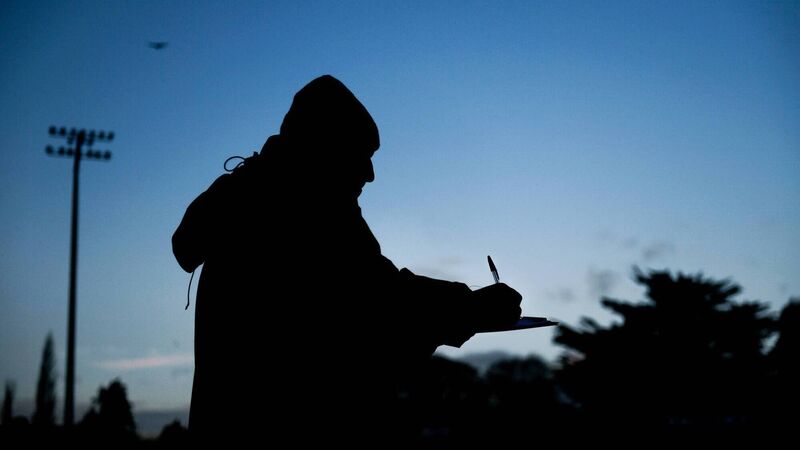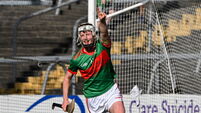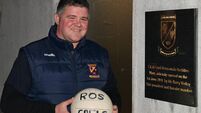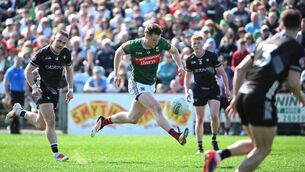Kieran Shannon: GAA needs to examine cursory attitude to backroom teams

Turlough O’Brien attributed much of Carlow’s resurgence on his beat to its county teams linking up with the resources and expertise available at the local IT. Photo by Stephen McCarthy/Sportsfile
While up north we’d the welcome development last weekend of 500 supporters being allowed back in to watch their county play, in the south we have a situation where even people involved day-to-day in the preparation of those teams still aren’t let in to see them.
Not that they’re crying about it, or that anyone else is going to cry for them. Indeed the public’s attitude to the prevailing GAA dictum that no more than 12 backroom members can be granted access to a match venue wouldn’t be too dissimilar to the inference headquarters had in rolling out that protocol again this year, an outlook that could accompany a Matt LeBlanc meme: Sure tough for them — there’s too many of them as is!
It’d be unfair to say that every GAA official shares that view. Patrick Doherty, who for over a decade worked in Croke Park as its games administration and national match officials manager, recently gave an interview in his current capacity as operations manager for Westmeath GAA and the match-day logistical challenges that go with the new normal.
“People sometimes think that there are a lot of hangers-on going with county teams at the moment but that’s not true at all,” he told gaa.ie. “When you consider that each team will have a couple of physios, a doctor, a kitman and a team secretary, that’s a lot of the backroom slots that are full before you ever go near things like coaches and stats men.”
For the most part though the view of the powers-that-be and indeed a contingent of the punditry class would seem to be more like Uncle Matt’s: A stats man, wha’?! Be the hokey! And who’s your friend there? A sports nutritionist?! Ah, Jaysus, stop! And tell me, do ye have to go to college to do that?
Ye can’t mark space lads pic.twitter.com/kFcgpQQVtX
— Barry Finnegan (@Barrywfinnegan) May 29, 2021
As a matter of fact, yes, Uncle Matt. And though it may be lost on you, when you’re implying there’s too many backroom members with GAA teams, what you’re effectively saying is there are too many sports courses provided by third-level institutions nowadays.
Maybe you preferred the old days, back in the 60s, when there wasn’t a single sports or physical education course available in this country and pioneers like Mickey Ned O’Sullivan and Billy Morgan and Joe Lennon had to go to Strawberry Hill in London.
Indeed, instead of being lauded for preaching the coaching gospel that he’d learned over there as well as from his involvement as captain of a magnificently innovative Down team, Lennon was condemned by the association’s president for propagating a “new cult” of “professionalism of the worst kind”. Sure coaching and coaches — what had that spoofery and those hangers-on to offer Gaelic Games?
By the 1970s when we’d be led to believe that Mick O’Dwyer and not Leo Griffin was the Kerry kitman as well as everything else, not only was he and Kevin Heffernan attending coaching courses run by Lennon and his sometimes-derided “Gormanston professors”, but some of their leading players like Brian Mullins and Pat Spillane and John O’Keeffe were able to study physical education in their own country with the birth of Thomond College.
But still it was very much the outlier. Indeed well into the late 1990s, outside of a few recreation management courses in several RTCs-ITs in Cork, Waterford and Tralee, there was next to no place to study sport outside Limerick.
And that lack of educational opportunity was reflected in the lack of education and science that went into ‘preparing’ inter-county and club teams. As much as there’s a tendency for some of the pundit class to look back on that era purely through rose-tinted glasses, the reality is much of it was spent on vomit-covered beaches and hills, condemning platoons of now middle-aged men to inappropriate training and premature hip replacements and a litany of other ailments and complications.
There was an upside to that era though. Not only did it trigger kids to dream someday of being a man who could level whole counties in one second flat but some of them figured out that if they couldn’t be that man they could at least help prepare the one who would.
In the noughties there was a proliferation of sports courses offered by third-level institutions everywhere. Sports science, sport psychology, sports coaching, health and exercise science, sports rehabilitation and athletic therapy, sport nutrition, sports performance analysis: you name it, there’s a course in it. In this country. You don’t have to go abroad to study it or even practise it.
And that’s a good thing. For everyone. Turlough O’Brien attributed much of Carlow’s resurgence on his beat to its county teams linking up with the resources and expertise available at the local IT. Damien Sheehan, the programme director of the colleges BSc in sports science, not only was the lead S&C coach and a selector with O’Brien’s senior footballers, but some of his students were able to serve internships with the team. It was mutually beneficial: the students were able to conduct studies and gain experience with a high-performance setup and that setup was able to learn from their findings and knowledge.
As Doherty alluded to earlier on, there’s still a common perception that there’s a lot of hangers-on involved with county teams these days and that the whole thing is a bit of a financial gravy train. But a bit like the impression that all those GPSs and wellbeing questionnaires players are asked to wear and fill are contributing to rather than reducing the likelihood of burnout, that’s not necessarily the case.
For one thing, a lot of backroom roles are carried out by volunteers. A majority of the 23-person Dublin management photographed after the 2016 All-Ireland final were natives, their only cost being on food, mileage and accommodation, just as providing the same to players takes up much of the budget of any county setup. And those who weren’t volunteers would have forked out personal fortunes to qualify and upskill in their professional field.
Although we sometimes hear that the county game is afflicted with spoofers, those who propagate that notion are probably the biggest spoofers of all. Dressing rooms are unforgiving places. Spoof and you’ll barely get a second audience, let alone a second season, with a group of county players.
And increasingly Croke Park is minimising the risk of such chancers. Its science and medical committee with its various subcommittees is continuously raising and demanding standards. Nowadays you need to have more than a pen and paper or even an iPad to do stats; there is now a GAA performance analysis quality assurance accredited programme.
And yet we also now have another strand of Croke Park seeing to it that some people who’ve taken that course can’t attend their teams’ games and pick up what GAAGo and its cameras can’t.
For sure there was a sound rationale to such a measure last winter. And we also learned back then that where there’s a will, there’s a way around it. As Christy O’Connor noted in these pages last month, one leading hurling setup in the 2020 championship had their stats team based in a hotel where they linked up to those at the ground.
But now that we know that Covid is barely transmittable outdoors, where would we prefer that stats team to be?
Unwittingly or not, it all gives an impression: We’d rather you weren’t here. You don’t need to be here.
And that’s a sad, even dangerous, message. Because again, a good share of these backroom members are either current or former students. The reason why they did their course, the reason why there was a demand for their course, was because of their passion for sport, especially GAA. (Of course, if these students, courses and graduates chose not to interact with the GAA, their current critics would be outraged).
And though there’s barely any professional sport in this country outside of five rugby operations, that passion for the GAA may be what has kept them in this country when classmates of theirs have emigrated. The chance to work with the county team, along with maybe getting a few quid doing S&C for a club team to go with a bit of lecturing, might just have been what swayed them to stay; they’re still in the country because they’re more romantics than cold-hearted professionals.
County teams do need to cut down on their costs. But if anything the current anti-backroom measures and sentiment would incentivise people in such roles to ensure they’re compensated.
There’s no way as nationalistic an institution as the GAA encourages emigration. But if we don’t want so many students and graduates of third-level sports courses in our dressing rooms, we’re either saying there’s too many of those courses in the country or there’s too many of those students and graduates staying in the country.










